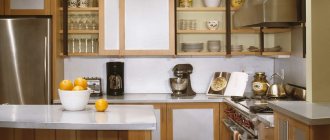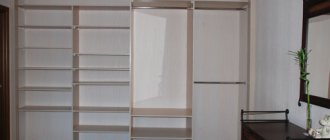16459
Every housewife has a significant number of different bedding items - pillows, blankets, which take up a lot of space. The question of organizing where to store them is always relevant, because such things cannot be put away in the closet, they must always be at hand so that you can easily and quickly get ready for bed in the evening. Of course, modern sofas and beds have special niches, drawers where bedding is placed, and you can also provide a place to store linen by selecting several shelves in the chest of drawers. However, how wonderful it is to have a special linen closet where all things will find their place and will be stored in perfect order. Folded blankets, neat, even stacks of bed linen, pillows, bedspreads - all this will fit perfectly in a linen closet.
Installing shelves
If the filling of the cabinet was not thought out in advance, it is worth “pumping” it yourself. It happens that the shelves provided by the manufacturer are located at a great distance from each other. A stack of folded clothes ends up too high and quickly creates clutter.
Typically, shelves are made from laminated chipboard, sawed to fit the width and depth of the cabinet, protecting the ends with an edge and fixing them with screws and shelf holders.
WE PLAN AND DRAW YOUR DREAM CLOSET
Things are stored in closets. There are wardrobes in our houses. The dream is to store things in such order that you can create your wardrobe in three minutes. And he is responsible for saving time around the clock - a super-spacious dream closet designed for 5 plus people.
The dream wardrobe is bought in a store or ordered from a workshop. But first you must remember to carefully plan each shelf and hook. Draw a plan. And only after that don’t be afraid to spend money on a purchase.
Do you think planning your closet is easy? I want to upset you. It will be difficult for an unprepared person. If I move a stack of sweaters from place to place thirty times a year. If I can't find the skirt I need. This means one thing - the closet is not thought out. Let's draw again!
And in order not to make any more mistakes, and especially not to throw money into the abyss, I wrote 1200 words about how to come up with each person’s own dream closet. I drew a lot of illustrations and am grateful for every “thank you” that I receive endlessly.
For work projects, I draw cabinets down to the last cubic centimeter. Together with our customers, we seriously discuss every storage system in their home. It doesn’t matter if it’s a closet or a dressing room, a small pantry or built-in shelves in niches.
Wardrobe for individual execution. Author Oksana Panteleeva. 2021 Implemented project
All cabinets are made at the factory. The algorithm is simple: I prepare sketch solutions, then surveyors go to the house or apartment. Next, the designer develops a storage system in accordance with the selected materials and filling of the cabinet. Then we coordinate again, sign the drawings, send them to work, wait, receive and rejoice at finding happiness.
But what if it is impossible to ask for help from professionals, and there is no hope for a manager in a furniture salon. Or are you planning to buy Pax at Ikea, where everything is sold in parts (cases, shelves, hooks) and you have to put in a lot of effort to get the cabinet of your dreams?
There is only one answer: you need to prepare and draw the closet yourself.
Photo of the cabinet. Completed project by Oksana Panteleeva's studio
It doesn’t matter what kind and where you plan to put the closet, the main thing is that it meets the objectives: convenient storage and quick search for things
10 steps to draw the perfect closet. Complete each one and I guarantee success!
Step 1. Understand where the closet will be located, for what purpose it is intended and what things will be stored there.
I divide cabinets according to this principle:
- The closet is shared between husband and wife.
- A closet just for him or just for her.
- Children's wardrobe.
- The closet is shared by the whole family.
- Wardrobe for outerwear only.
- Wardrobe for all clothes, excluding outerwear.
- Wardrobe with mezzanines or without mezzanines.
The first step is important - it’s one thing if we are planning a closet in the hallway for outerwear and quite another if it is located in the bedroom. A clear purpose of the cabinet is a 50% guarantee of success.
Useful on the topic: How to arrange a small hallway.
Step 2: Understand the actual size of the cabinet that will fit in your specific space. You can think and dream about many things, but reality will offer other options.
An ill-thought-out closet is a disaster. Especially if you try to fit everything and even more into it. In the same place, the same closet will hold 10 coats, but will never hold 10 fur coats. Because the volume of fur coats and fur coats is different. And they occupy a different number of centimeters on the hangers. Let’s avoid mistakes, read the article to the end and draw an ideal storage system.
Useful on the topic: How to properly install a cabinet in a niche
illustrations by Oksana Panteleeva
Step 3. Sort all items for storage.
Divide things into: those stored on hangers and those stored on shelves. Dresses separately, T-shirts separately.
At first, the action may seem nonsense, but this is the only way you will understand how many shelves you need for: sweaters, T-shirts and how many hangers you need to buy.
Advice from personal experience: divide your things into piles, piles, take a tailor's yardstick and measure them. In 2009, I painted a hundred sheets and it looked like this:
“My sweaters – 5 pcs., a stack of 20 cm.
My husband’s sweaters – 10 pcs., a stack of 34 cm. My husband’s suits – 10 pcs. – I need 50 cm for the hangers of my dresses – 20 pcs.
“Can I throw out half of it?” Step 4. Throw away everything unnecessary.
Feel free to send anything obsolete to the landfill. Approach the process of getting rid of old, irrelevant things critically. Today there is a lot of talk on the topic of “suffering from materialism,” so let’s not suffer, but save space.
Haven't worn the item in the last six months or a year? Give to friends, charity or recycling. Old items will be accepted at the HM store and in return they will give you a discount coupon. As Diana Balashova says in an article about asceticism: “I bought a bag with new things, and threw away the same bag at home.”
Read Diana’s full article about love for space on the blog pages here .
Step 5. Measure all lengths of things.
Don't be surprised by this step and don't skip it, please! Dresses and coats, raincoats and men's suits - everything has its own length, which will tell you how much space to allocate inside the closet.
The difference between a long evening dress and a men's shirt is up to 100%. And if you are the happy owner of a collection of floor-length dresses, then be sure to think about a separate compartment. The length of the dresses will be the main parameter, since under no circumstances should the hems be allowed to lie at the bottom of the closet.
Step 6. Think about how to store hats and small accessories.
Review the options for storing ties, handkerchiefs, and belts on the Internet and choose the most convenient one. I advise you to create an account on Pinterest and put the photos you like in separate folders.
Determine the main thing for yourself: in this closet you will store caps, hats, small accessories, or they will find another place in the house.
Step 7. Think about how blankets , pillows, and large out-of-season items will be stored.
Usually in closets there are mezzanines, the topmost shelves, or deep drawers at the bottom, similar to the principle of a chest of drawers, for “large size”. If there is no separate storage room for storing such things, then we plan shelves in the closets. Don't forget guest pillows and winter blankets.
We remember that there are useful vacuum bags on sale that are convenient for storing bulky items. They take up much less space on a shelf or inside a drawer, because your vacuum cleaner and a special valve will work wonders, remove excess volume, and with it save centimeters in the closet.
Step 8. Think about where we store suitcases and large bags.
The suitcase also needs to be stored somewhere. If there is only one closet, then you need to allocate space for bags and suitcases. And following the rule of “saving space” and caring for space, we remember that we always store something “sometimes necessary” inside the suitcase.
I keep bags and backpacks in my suitcases that I use when traveling. The swimming mask and snorkel also live in the suitcase.
Step 9. Consider storing sports equipment.
Skis, boots, poles, skates - everything needs a place. In addition, you must take into account all the manufacturer’s recommendations for storing sports equipment.
For example, I was faced with the fact that expensive alpine skis should be stored only in a certain way: either on special mounts, or strictly in a horizontal position. And I solved a real problem: how to find a place in the customer’s apartment to satisfy the manufacturer’s requirements. Everything was thought out before purchasing the cabinet - this is important.
I have a storage room in my apartment where I store bicycles and skates. We always rent skis.
Step 10. Think about shoe storage.
Shoes, as experience has shown, are the most painful place when it comes to storage. When this article was first published (the first edition was in 2014), there were a lot of complaints about the main illustration. How dare I suggest storing shoes with dresses! No one noticed that this was just an illustration of the size range of things, and not a guide to action.
We are different.
Some people store shoes in their original boxes and put out-of-season sandals in the closet. Someone loves beautiful shoe boxes with transparent walls in a common closet, and does not change their places in spring and autumn.
When possible, I prefer a separate shallow closet just for shoes over all options.
There are plenty of options. Force yourself to count the number of shoes at home. Decide on your preferences and find the perfect boot and shoe storage option for your family.
10 steps behind and now the finest hour has come! Let's get to work: take paper, a scale ruler and a pencil.
We draw the perimeter of the cabinet. Its length, height. We immediately decide on the opening system: swing doors or sliding doors.
An example of the “perimeter” of Emma’s closet with 6 hinged fronts, which should fit into a niche 300*270 cm and 65 cm deep:
Important:
The depth of a standard cabinet with hinged doors is 60 cm or 600 mm.
If your closet is shallower in depth, please note that the hangers will be positioned differently.
Wardrobe with sliding doors – 70 cm. The exact depth depends on the technical characteristics of the sliding system you have chosen. Please note that today manufacturers have a good choice; the “coupe” system is not the only one and not the best.
The standard size of hangers is 50-55 cm .
Next, distribute the cabinet compartments according to the opening of the doors. Pay attention to this so that you never do this:
example of a cabinet from the resource www.extension-renovation.fr
The interior organization of the cabinet is good, and the doors open in such a way that it is inconvenient to use.
We distribute things according to your measurements, which we talked about above. Or turn to Ernst Neufert's textbook, where you will find the basics for designing cabinets. ( * Ernst Neufert is a German architect, architectural theorist. “Building Design,” one of his most important works, has become a reference book for me and my colleagues.)
Since I cannot draw each of you an individual dream closet, the basics of E. Neufert and my article will help you do this yourself.
Basics. Part I. Man:
It is important to know how much space a person takes up on average when: trying to reach the top shelf of a closet, or looking for something on the lowest one, or if he stands on a stool. This has a lot to do with the cabinet design process. See illustration:
I redrawn the pictures from E. Neufert's textbook so that they perfectly illustrate where the hand of a person of average height can reach.
It can be seen that dresses and coats can be placed at a height of 2 meters, and if higher, then you need to buy a furniture pantograph.
Basics. Part II. Cloth:
We measure all clothes.
It is clearly seen that, for example, one dress can be from 140 to 165 cm (let me remind you - these are very average clothing sizes, so I advise you to try on your dresses), and 5 dresses on hangers in a row will take up 30 cm on the crossbar.
If the trousers are stored folded, they will take 120 cm. And if they are stretched out, then 140-150 cm.
Make the height of the space above the crossbar at least 5 cm
.to use the hanger comfortably.
A convenient shelf height for low shoes is 17-20 cm.
, if shoes are stored in their normal position and not on special stands.
For high boots, leave a free space of up to 50 cm high
.
The average height of a boot is 40-41 cm.
Small items: socks, handkerchiefs, underwear are best stored in drawers or baskets. I love drawers with good bottoms and easy opening. In the designed cabinets I put drawers that, instead of regular handles, have a cutout for the arm.
This is a great and smart article.
I think there are no more questions about why we count all our dresses and measure the length of fur coats in order to draw a closet.
Don't forget to leave room for a new dress, so that even despite the advice - do not clutter the space. Dreams should come true, and if today your dream is a new dress, then you need to buy it!
Emma also counted the outfits and found a place for dresses and hats. As a result, she ended up with this drawing:
The drawing is conditional; it is not a guide to action, but a basis for further work. Now it's time to go looking for a cabinet manufacturer.
There is an article on the blog: “How to find the ideal manufacturer of your dream kitchen” - I advise you to read it and learn the basics that are suitable for finding a cabinet manufacturer.
Do full work not only on the wardrobe. Housekeeping also requires attention.
Wardrobe for individual execution. project by O. Panteleev. 2021.
Today we had a conversation on a super topic: how to plan and draw a closet yourself.
You learned:
- 10 steps you need to go through to achieve your goal - a good, comfortable wardrobe.
- We received a visual aid in the author's unique illustrations by Oksana Panteleeva
- We were inspired by beautiful drawings and tips.
Therefore, no excuses can now be accepted - draw your cabinets, send them by email to the blog “on the wave of decor, so that we fill the gallery of our readers’ achievements!
And another article to help: Organizing your closets is the key to success.
me in front of the new cabinet from Silver Home 2021. Postscript:
This article received a second edition in 2021. New illustrations and new tips. The first edition received hundreds of reposts and was very popular on the Internet. I kindly ask you not to steal articles and illustrations, do not erase my name and blog name from the pictures. Those to whom I address know what I am talking about. If you want to use the materials, I don’t mind, but an active link indicating the resource and author is required. It is not difficult. You will be respected.
Each article is written personally, illustrations for the articles are drawn by me myself. Each article takes a lot of time and effort, once again I ask you to respect the work. Let's live in peace! Thank you!
And thanks for your attention! Stay with me, be sure to share with your friends, wait for new interesting articles! AND…
GOOD LUCK WITH THE REPAIR!
The blog “On the Wave of Decor” is a non-commercial project and is created only by the author. If you appreciated the article and liked it, I would be grateful for a little financial support. Thank you!
Hanging baskets
If creating additional shelves and rods is difficult, you can purchase special hanging baskets. They are durable because they are made of metal and, unlike textile ones, do not bend under the weight of clothing. They can be attached to each other, placing them as conveniently as possible.
Rules for selection and placement
When choosing a cabinet, you should consider many parameters:
- Purpose. If this is a bed option, then it should have more spacious shelves. If the product is required for storing clothes, then it is reasonable to pay attention to models with a barbell, shelves and drawers at the same time.
- Design. For a classic interior, you should choose massive stationary cabinets made of natural wood. It is desirable that their surface be decorated with exquisite patterns. In the English, country and Provence styles, solid wood products are appropriate, small but roomy, decorated with floral and other ornate patterns. For any modern trend, you can purchase furniture with a glossy surface, preferably sliding wardrobes. Inserts made of glass, mirrors and metal can be used as decoration.
- Manufacturing materials. The durability of the product depends on them. Wooden models are considered the most durable.
- Appearance. When choosing, you need to carefully inspect the furniture; there should be no defects, chips, or scratches on it.
- Internal filling. Must match the purpose of the cabinet.
- Price. The most expensive wardrobes are made of solid wood, the cheapest options are made of fabric and plastic.
As a rule, a linen closet is installed in the bedroom. For a spacious room, choose stationary structures, and for a small room, built-in or corner ones. Recently, they have started installing cabinets in the bathroom. Towels, bathing accessories, and household chemicals are stored there. Usually these are models made of plastic or fabric, miniature, light and comfortable.
If the closet is intended for storing bedding, then it should have more spacious shelves
The classic interior will be complemented by massive stationary cabinets made of natural wood.
Wooden models have a long service life
When choosing, you need to carefully inspect the furniture, eliminating possible defects, chips or scratches.
Inexpensive plastic cabinet models can be installed in the bathroom for storing towels or household chemicals
Improving hangers
To prevent clothes from becoming wrinkled, you should store them on hangers. But you shouldn’t place it in layers: it’s inconvenient and impractical. Identical thin hangers, as well as multi-tiered products that leave all things in sight, will help save a little space.
Ordinary hangers can be easily improved by fastening them with keys from aluminum cans. A plastic chain will also come to the rescue, allowing you to arrange your clothes vertically.
We operate the frame and door
For compact storage of accessories, it is worth using the walls and doors of the cabinet. For example, attach hooks for bags, rails for belts, jewelry or ties to them. Look carefully at what space remains unused on the side wall - perhaps this is where it will be convenient to attach a basket or wicker bag for small items.
We introduce organizers
The downside to small items of clothing (socks, underwear and tights) is that if stored incorrectly, they create clutter and are easily lost. To solve this problem, laundry should be kept in roll-out drawers, using lightweight fabric organizers that fit the size of the structure.
It’s easy to make all kinds of dividers with your own hands - cardboard boxes and paper folders will do. If desired, you can use PVC pipe cut into small pieces. Belts, scarves and socks will fit there.
Filling
The contents of the cabinet also differ depending on the model:
- Shelves - there are stationary and retractable, designed for bed linen, towels and things that can be stored folded.
- Drawers (usually pull-out) - can be equipped with dividers. Designed for storing small items of clothing: underwear, socks, scarves.
- Hanging rod - can be stationary or retractable. Suitable for storing clothes that cannot be wrinkled.
- Mesh shelves are specially designed for storing shoes.
- Rails for trousers or skirts - allow you to keep things ironed.
- Area with hooks - for bags, ties, scarves and other similar accessories.
Most manufacturers offer several variations of internal filling for a specific cabinet model. When making a product to order, you can choose absolutely any internal elements.
Shelves
Boxes
Hanging rod
Mesh shelves
Crossbars for trousers or skirts
Hooks for ties, belts
Bar with bag holders
Save money with air
If there is a catastrophic lack of space, you should go to the “heavy artillery” and pack seasonal items in vacuum bags. They reduce the volume of clothing several times. In summer, down jackets and thick sweaters should be stored compressed, and in winter, light dresses and tops. The main thing is to put things that you definitely won’t need on the far shelves, and also remember that after removing the fabric you will have to iron it.
Organization of space in the wardrobe
Classic cabinets give a feeling of limitation and crampedness. In addition, they do not allow rational use of organized storage space. Standard furniture is being replaced by an open wardrobe. In addition, it is suitable for a small apartment that does not have room for a large wardrobe.
To organize storage space, allocate some space in one of the rooms. Separate the space with narrow shelving. The result is a compact and spacious dressing room. Mobile clothing racks will save even more space. They are suitable for compact rooms and will become an original element of the interior. Such stands will appeal to lovers of minimalistic and laconic design.
But if you prefer closed storage, organizing your closet space will require careful attention and planning. Thoughtful and rational storage of things will save useful space, allow you to quickly and easily find the necessary items, maintain order in the apartment, and keep your clothes clean and fresh for a long time. Even more tips on how to properly store things in a closet are presented at the link.
We use the interceiling space
When ordering a built-in wardrobe, you should build it right up to the ceiling, but if the structure is already ready and there is unused space at the top, you should fill it beautifully and usefully.
Today it is easy to find wicker baskets or beautiful boxes on sale, and you can also make them yourself. A vintage suitcase will also come in handy as it will add character to the interior. Inside you can store rarely used shoes and clothes, spare blankets and textiles.
A rational approach to storing things will help make life more comfortable and save not only space, but also time.
Varieties
The linen closet has many varieties. These pieces of furniture differ in the way the doors open. There are models with hinged doors. These are products familiar to everyone, in which in order to open the wardrobe, you need to pull the door towards you. This option takes up a lot of space, since free space is needed for the valves to function fully. On the other hand, swing doors are durable and rarely break.
Another option is a wardrobe. This is a relatively new type of furniture, which is very popular today. The wardrobe doors slide to the side when opened. They do not take up extra space, which is very convenient, especially if the room is small. On the other hand, it is important to choose a strong mechanism, otherwise it will quickly become unusable. In addition, if you place the wardrobe on an uneven floor, the doors will not work. Such doors require a perfectly flat surface.
Materials for making furniture, types of wardrobes
Another model is an open pencil case. Such a closet has no doors at all; laundry is stored in plain sight. Not everyone likes this option. Although you can decorate the closet in an interesting way, for example, place beautiful baskets on the shelves for storing things.
Swing
Closet
Open
In addition, cabinets are divided into types according to the type of construction:
- Built-in models. Made to order, for a specific room, size. They are convenient because they can be installed in a free niche of the room, even under the stairs. Behind such a product you can hide ugly elements, for example, beams or counters, pipes. But a built-in wardrobe cannot be moved to another location at will or resold. If you want to change the interior, you will need to dismantle the structure.
- Case models. These can be purchased everywhere, they are installed in any free part of the room and, if necessary, moved. As a rule, such cabinets are quite bulky, and besides, it is not always possible to choose a model for a specific room (place it in a niche or corner, under the stairs).
Built-in
Cabinet
Cabinets also differ in their shape. They are straight (linear), angular and radial. The first ones have a rectangular shape and are installed along the wall of the room. The latter occupy a free corner, which is usually difficult to fill rationally. As a rule, these are sliding wardrobes. Radius models have rounded facades; more often they are made angular.
Straight
Angular
Radial
Standard dimensions of the corner triangular model:
- The length of the walls is 1.2 m.
- Depth 40 cm.
- Height 2 m 35 cm.
The minimum dimensions of a diagonal cabinet are 170 x 70 x 50 cm, the maximum are 250 x 240 x 70 cm. Trapezoidal models have different parameters: the length of one wall is 120 cm, the other is 80 cm, depth is 45 cm. Radius products are not standard in height more than 240 cm, width up to 210 cm, depth up to 80 cm.











